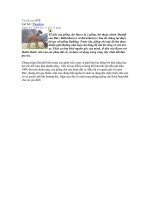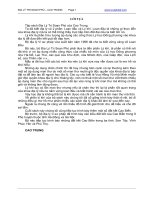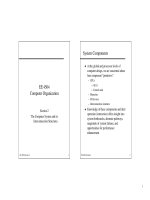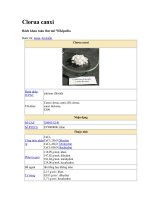Tài liệu Lightning Protection pdf
Bạn đang xem bản rút gọn của tài liệu. Xem và tải ngay bản đầy đủ của tài liệu tại đây (160.11 KB, 3 trang )
"Lightning Protection"
Why You Need Lightning Protection:
Lightning protection systems have changed drastically since Benjamin Franklin first invented lighting rods in
1752. Today's systems must protect modern appliances, electrical systems and building constructions - they
have to keep up with tile changing requirements of modern technology.
Underwriters Laboratories Inc. (UL) keeps up with these changes. Our experience in the safety testing field
has earned UL worldwide recognition and respect. jurisdictional authorities, government agencies, insurance
representatives and consumers alike have looked for the UL Mark on products and systems for almost100
years. When you see the Mark, it means that the product or system on which it appears compares with UL's
internationally recognized Standards for Safety.
In the lighting protection field, UL has been serving home and building owners since 1908. Today, UL has a
large number of trained lighting protection field representatives located throughout tile United States. UL
inspects sites ranging from cow barns to missile silos, front golf Course shelters to high-rise building systems.
In fact, some of the most famous buildings in the world are protected by UL Master Labeled lightning
protection systems, including the White House, the Sears Tower and the Washington Monument.
The Need for Lightning Protection:
Lightning can strike anywhere on earth - event the North and South Poles! In any U.S. geographical location,
lightning storms occur as few as five times or as many as 100 times per year (see Fig. 1). -The Northeast
United States has the most violent thunderstorms in the country because of the area's extremely high earth
resistivity (see Fig. 2). High earth resistivity (the earth's resistance to conduct current) increases the potential
of a lightning strike. If struck, structures in these areas will generally sustain more damage when there is no
lightning protection system present.
Each year, thousands of homes and other properties are damaged or destroyed by lightning. It accounts for
more than a quarter billion dollars in property damage annually in the United States. Lightning is responsible
for more deaths and property loss than tornadoes, hurricanes and floods combined, but of these violent forces
of nature, lightning is the only one we call economically afford to protect ourselves against.
Some properties have a higher risk of lightning damage. When considering installation of a lightning
protection system, you may want to assess this risk. A risk assessment guide for determining lightning loss for
all types of structures can be found in Appendix I of the National Fire Protection Association's Lightning
Protection Code, NFPA 780. This guide takes into consideration the type of structure, type of construction,
structure location, topography, occupancy, contents and lightning frequency. Information may be obtained
from tile NFPA, I Batterymarch Park, Quincy, MA, 02269, (800) 344-3555.
Generated by Foxit PDF Creator © Foxit Software
For evaluation only.
How a Lightning Protection System Works:
Lightning is the visible discharge of static electricity within a cloud, between clouds, or between tile earth and
a cloud. Scientists still do not fully understand what causes lightning, but most experts believe that different
kinds of ice interact in a cloud. Updrafts in the clouds separate charges so that positive charges moves end up
at the top of the cloud while negative flow to the bottom. When the negative charge moves down, a "pilot
leader" forms. 'This leader rushes toward the earth in 150-foot discrete steps, ionizing a path in the air. 'The
final breakdown generally occurs to a high object the major part of the lightning discharge current is then
carried in the return stroke which flows along the ionized path.
A lighting protection system provides a means by which this discharge may enter or leave earth without
passing through and damaging non-conducting parts of a structure, such as those made of wood, brick, tile of-
concrete. A lightning protection system does not prevent lightning from striking; it provides a means for
controlling it and preventing damage by providing a low resistance path for the discharge of lightning energy.
FIG. 3 Lightning protection system for a dwelling: 1) air terminals spaced 20 feet apart along ridges and
within two feet of ridge ends; 2) down conductors; 3) minimum of two groundings at least 10-feet deep; 4)
roof projections such as weather vanes connected to system; 5) air terminal located within two feet of outside
corners of chimney; 6) dormers protected; 7) antenna mast connected to roof conductor:- 8) connect gutters or
other grounded metals as required; 9) surge arrester installed at service panel to protect appliances; 10)
transient voltage surge suppressors installed in receptacles to which computers and other electronic equipment
are connected.
FIG. 4 Lightning protection system commercial/industrial installation 1) air terminals spaced 20 feet apart
around the perimeter of the building; 2) down conductors; 3) ground rods at least 10-feet deep; 4) art handling
units bonded to system (may be in need of air terminals mounted on unit); 5) air terminals mounted within
two feet of outside corner; 6) mid-roof conductor and air terminals at maximum 50-foot spacing; 7) grounded
metal bodies bonded into system; 8) surge arresters installed at main electrical panels; 9) transient voltage
surge suppressors installed in receptacles to protect computers and other office equipment.
UL's Role in Lightning Protection:
UL's Master Label Program for lightning protection involves periodic factory testing and inspection of system
Components, along with field inspection components of completed installations. The program requires that all
installers comply with UL’s internationally recognized Standards for lightning protection components and
systems. UL,’s field representatives countercheck compliance with these Standards.
As a home or building owner, you should make sure that your installed system complies with the UL
requirements. Here’s how:
Make certain that your installer is listed by UL and that a Master Label application is submitted to UL for
your installation.When You request a Master Label for your system, your installer will ask you to sign the
owner’s statement on the Master Label application form. The fourth (yellow) copy of the application is for
your records. This should be done before the installer submits the Master Label application to UL for issuance
of the Label. Make sure you receive the Master Label from the installer and place it on the protected structure
as requested.
Generated by Foxit PDF Creator © Foxit Software
For evaluation only.
Buildings that are changed structurally or provided with additions can be re-examined under UL’s
Reconditioned Lightning Protection Program. Under this program, the entire system must comply with the
current UL Standards.
How You Can Protect Your Building:
1. Install a UL Master Label Lightning Protection System that complies with current nationally
recognized codes. Lightning protection systems consist of air terminals (lightning rods) and associated
fittings connected by heavy cables to grounding equipment, providing a path for lightning current to
travel safely to ground.
2. Install UL Listed surge arresters at your service and telephone equipment to prevent surges from
entering the home or other buildings oil power or telephone lines. Surges are diverted to ground, and
both wiring and appliances are protected.
3. Install UL Listed transient voltage surge suppressors in receptacles to which computers and other
electronic equipment are connected in order to limit the voltage to 11/2 times the normal (maximum
for solid state devices).
4. Look for the UL Mark. Remember, your lightning protection system may be installed using UL,'s
requirements, but the system is not a Master Label system unless installed by one of UL's Listed
installers and a Master Label has been sent to you. Always "Look for the Master Label" on your
lightning protection installation.
2007, Electricians Toolbox Etc...
Design by TC
c
Generated by Foxit PDF Creator © Foxit Software
For evaluation only.









